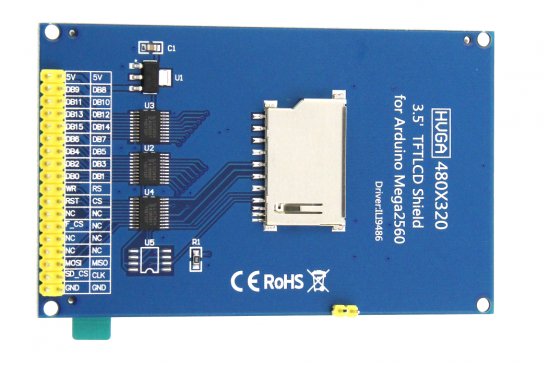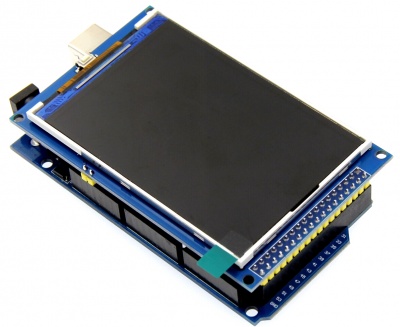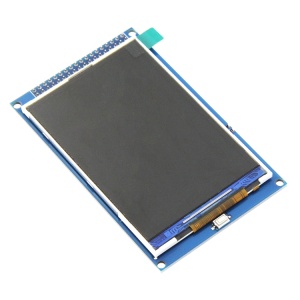More actions
Created page with "123" |
|||
| (17 intermediate revisions by 2 users not shown) | |||
| Line 1: | Line 1: | ||
{{lan | |||
| | |||
cn=http://www.lcdwiki.com/zh/3.5inch_Arduino_Display-Mega2560 | |||
| | |||
en=http://www.lcdwiki.com/3.5inch_Arduino_Display-Mega2560 | |||
}} | |||
== <font color="blue">Product Picture</font> == | |||
[[File:MAR3513-007.jpg|300px]] | |||
[[File:MAR3513-008.jpg|300px]] | |||
==<font color="blue">Product Description</font> == | |||
* 3.5-inch color screen, support 65K color display, display rich colors | |||
* 320x480 HD resolution for clear display | |||
* Fast transmission with 16-bit parallel bus | |||
* On-board 5V/3.3V level shifting IC, compatible with 5V/3.3V operating voltage | |||
* Support Arduino Mega2560 direct plug-in use | |||
* Provides an Arduino library with a rich sample program | |||
* Easy to expand the experiment with SD card slot | |||
* Military-grade process standards, long-term stable work | |||
* Provide underlying driver technical support | |||
==<font color="blue">Product Parameters</font> == | |||
{| class="wikitable" border="1" style="width: 500px; background-color: white;" | |||
| align="center" |Name | |||
| align="center" |Parameter | |||
|- | |||
| align="center" |Display Color | |||
| align="center" |RGB 65K color | |||
|- | |||
| align="center" |SKU | |||
| align="center" |MAR3513 | |||
|- | |||
| align="center" |Screen Size | |||
| align="center" |3.5(inch) | |||
|- | |||
| align="center" |Type | |||
| align="center" |TFT | |||
|- | |||
| align="center" |Driver IC | |||
| align="center" |ILI9486 | |||
|- | |||
| align="center" |Resolution | |||
| align="center" |480*320 (Pixel) | |||
|- | |||
| align="center" |Module Interface | |||
| align="center" |16-bit parallel interface | |||
|- | |||
| align="center" |Active Area | |||
| align="center" |48.96x73.44 (mm) | |||
|- | |||
| align="center" |Module PCB Size | |||
| align="center" |60.30x96.60 (mm) | |||
|- | |||
| align="center" |back light | |||
| align="center" |6 chip HighLight white LEDs | |||
|- | |||
| align="center" |Operating Temperature | |||
| align="center" | -20℃~60℃ | |||
|- | |||
| align="center" |Storage Temperature | |||
| align="center" | -30℃~70℃ | |||
|- | |||
| align="center" |Operating Voltage | |||
| align="center" |5V/3.3V | |||
|- | |||
| align="center" |Power Consumption | |||
| align="center" |TBD | |||
|- | |||
| align="center" |Product Weight(Package containing) | |||
| align="center" |about 49(g) | |||
|} | |||
==<font color="blue">Interface Definition</font> == | |||
[[file:MAR3513-001.png|550x550px|left]] | |||
{| class="wikitable" border="1" style="width: 650px; background-color: white;" | |||
! align="center" |Number | |||
! align="center" |Module Pin | |||
! align="center" |Pin Description | |||
! align="center" |Number | |||
! align="center" |Module Pin | |||
! align="center" |Pin Description | |||
|- | |||
| align="center" |1 | |||
| align="center" |5V | |||
|Positive power supply | |||
| align="center" |2 | |||
| align="center" |5V | |||
|Positive power supply | |||
|- | |||
| align="center" |3 | |||
| align="center" |DB8 | |||
|8th bit of data bus | |||
| align="center" |4 | |||
| align="center" |DB9 | |||
|9th bit of data bus | |||
|- | |||
| align="center" |5 | |||
| align="center" |DB10 | |||
|10th bit of data bus | |||
| align="center" |6 | |||
| align="center" |DB11 | |||
|11th bit of data bus | |||
|- | |||
| align="center" |7 | |||
| align="center" |DB12 | |||
|12th bit of data bus | |||
| align="center" |8 | |||
| align="center" |DB13 | |||
|13th bit of data bus | |||
|- | |||
| align="center" |9 | |||
| align="center" |DB14 | |||
|14th bit of data bus | |||
| align="center" |10 | |||
| align="center" |DB15 | |||
|15th bit of data bus | |||
|- | |||
| align="center" |11 | |||
| align="center" |DB7 | |||
|7th bit of data bus | |||
| align="center" |12 | |||
| align="center" |DB6 | |||
|6th bit of data bus | |||
|- | |||
| align="center" |13 | |||
| align="center" |DB5 | |||
|5th bit of data bus | |||
| align="center" |14 | |||
| align="center" |DB4 | |||
|4th bit of data bus | |||
|- | |||
| align="center" |15 | |||
| align="center" |DB3 | |||
|third bit of data bus | |||
| align="center" |16 | |||
| align="center" |DB2 | |||
|2nd bit of data bus | |||
|- | |||
| align="center" |17 | |||
| align="center" |DB1 | |||
|1st bit of data bus | |||
| align="center" |18 | |||
| align="center" |DB0 | |||
|0 bit of data bus | |||
|- | |||
| align="center" |19 | |||
| align="center" |RS | |||
|LCD register / data selection signal | |||
Low level: register, high level: command | |||
| align="center" |20 | |||
| align="center" |WR | |||
|LCD write control signal | |||
|- | |||
| align="center" |21 | |||
| align="center" |CS | |||
|LCD screen select control signal, low level enable | |||
| align="center" |22 | |||
| align="center" |RST | |||
|LCD reset control signal, low reset | |||
|- | |||
| align="center" |23 | |||
| align="center" |NC | |||
|Undefined, reserved | |||
| align="center" |24 | |||
| align="center" |NC | |||
|Undefined, reserved | |||
|- | |||
| align="center" |25 | |||
| align="center" |NC | |||
|Undefined, reserved | |||
| align="center" |26 | |||
| align="center" |F_CS | |||
|SPI flash chip select control signal | |||
|- | |||
| align="center" |27 | |||
| align="center" |NC | |||
|Undefined, reserved | |||
| align="center" |28 | |||
| align="center" |NC | |||
|Undefined, reserved | |||
|- | |||
| align="center" |29 | |||
| align="center" |NC | |||
|Undefined, reserved | |||
| align="center" |30 | |||
| align="center" |NC | |||
|Undefined, reserved | |||
|- | |||
| align="center" |31 | |||
| align="center" |MISO | |||
|SPI bus input signal | |||
| align="center" |32 | |||
| align="center" |MOSI | |||
|SPI bus output signal | |||
|- | |||
| align="center" |33 | |||
| align="center" |CLK | |||
|SPI bus clock signal | |||
| align="center" |34 | |||
| align="center" |SD_CS | |||
|SD card select control signal, low level enable | |||
|- | |||
| align="center" |35 | |||
| align="center" |GND | |||
|Power ground | |||
| align="center" |36 | |||
| align="center" |GND | |||
|Power ground | |||
|} | |||
==<font color="blue">Connect to Arduino</font> == | |||
{| class="FCK__ShowTableBorders" align="left" | |||
|- | |||
![[file:MAR3513-010.jpg|无框|400x400px]] | |||
|- | |||
| align="center" | '''Arduino Mega2560 direct insertion picture''' | |||
|} | |||
<br clear="all"> | |||
==<font color="blue">How to use on Arduino</font> == | |||
*'''Step 1: Download the test program''' | |||
# Download the Arduino test program from the [[#Program Download|'''Program Download''']] column | |||
# For a description of the relevant test procedures, please refer to the test program documentation in the package | |||
*'''Step 2: Connect the Arduino development board''' | |||
# Plug the module directly into the Arduino development board ([[#Connect to Arduino| <font color="red"> '''Do not plug in?'''</font>]]) | |||
# After the module is plugged in, power on the Arduino board | |||
*'''Step 3: Copy the dependent library''' | |||
# Make sure the Arduino IDE is installed on your computer (if it is not installed: [https://www.arduino.cc/en/Main/Software '''Arduino IDE download URL''']) | |||
# After installing the Arduino IDE, you need to copy the dependent library to the Arduino project directory as follows: | |||
::(1) Decompress the downloaded test package | |||
::(2) Copy the dependent libraries in the <font color="red"> '''Install libraries'''</font> directory in the package (shown below) to the <font color="red">'''libraries'''</font> folder | |||
:::of the Arduino project directory ([http://www.lcdwiki.com/res/PublicFile/Arduino_IDE_Use_Illustration_EN.pdf <font color="red"> '''Don't know the Arduino project directory?'''</font>]) | |||
::[[File:MAR3201-011.jpg|500px]] | |||
*'''Step 4: Compile and download the program to the development board''' | |||
# Open the sample in the Example directory of the package to test, compile and download([http://www.lcdwiki.com/res/PublicFile/Arduino_IDE_Use_Illustration_EN.pdf <font color="red"> '''Don't know how to compile and download?'''</font>]) | |||
*'''Step 5: Observe the running of the program''' | |||
# After the program is downloaded, run it directly and observe the running status. If it can be displayed normally, the program runs | |||
::successfully, as shown in the following figure (take the colligate_test test program as an example): | |||
::[[File:MAR3513-003.jpg|150px]] [[File:MAR3513-004.jpg|150px]] | |||
==<font color="blue">Program Download</font> == | |||
* [http://www.lcdwiki.com/res/Program/Arduino/3.5inch/Mega2560_16BIT_ILI9486_MAR3513_V1.0/3.5inch_Arduino_Mega2560_16BIT_Module_ILI9486_MAR3513_V1.0.zip '''3.5 inch Arduino Mega2560 module package'''] | |||
==<font color="blue">Product Documentation</font> == | |||
* [http://www.lcdwiki.com/res/MAR3513/3.5inch_Arduino_16BIT_Module_MAR3513_User_Manual_EN.pdf '''3.5 inch Arduino Mega2560 Module User Manual'''] | |||
* [http://www.lcdwiki.com/res/MAR3513/3.5inchQD3503728-Spec-V1.0.pdf '''3.5 inch TFT Specifications'''] | |||
* [http://www.lcdwiki.com/images/7/7f/MAR3513-002.png '''3.5 inch Arduino Mega2560 Module Size Picture'''] | |||
* [http://www.lcdwiki.com/res/MAR3513/Altium_3.5_44pin_QD-TFT3504_Package_library.zip '''3.5 inch QD-TFT3504 TFT LCD Schematic and PCB Package Library'''] | |||
* [http://www.lcdwiki.com/res/MAR3513/Datasheet-ILI9486.pdf '''Driver IC ILI9486 Data sheet'''] | |||
==<font color="blue">Reference Materials</font> == | |||
* [http://www.lcdwiki.com/res/PublicFile/Arduino_IDE_Use_Illustration_EN.pdf '''Arduino IDE software use illustration'''] | |||
* [http://www.lcdwiki.com/res/PublicFile/C51_Keil%26stc-isp_Use_Illustration_EN.pdf '''C51 Keil and stc-isp software use illustration'''] | |||
* [http://www.lcdwiki.com/res/PublicFile/STM32_Keil_Use_Illustration_EN.pdf '''STM32 keil software use illustration'''] | |||
* [http://www.lcdwiki.com/res/PublicFile/PCtoLCD2002_Use_Illustration_EN.pdf '''PCtoLCD2002 software use illustration'''] | |||
* [http://www.lcdwiki.com/res/PublicFile/Image2Lcd_Use_Illustration_EN.pdf '''Image2Lcd software use illustration'''] | |||
* [http://www.lcdwiki.com/Chinese_and_English_display_modulo_settings '''Chinese and English display modulo settings'''] | |||
==<font color="blue">Common Software</font> == | |||
* [http://www.lcdwiki.com/res/software/PCtoLCD2002.zip '''PCtoLCD2002'''] | |||
* [http://www.lcdwiki.com/res/software/Image2Lcd.zip '''Image2Lcd'''] | |||
[[#top|BACK TO TOP]] | |||
Latest revision as of 17:12, 2 November 2019
Product Picture
Product Description
- 3.5-inch color screen, support 65K color display, display rich colors
- 320x480 HD resolution for clear display
- Fast transmission with 16-bit parallel bus
- On-board 5V/3.3V level shifting IC, compatible with 5V/3.3V operating voltage
- Support Arduino Mega2560 direct plug-in use
- Provides an Arduino library with a rich sample program
- Easy to expand the experiment with SD card slot
- Military-grade process standards, long-term stable work
- Provide underlying driver technical support
Product Parameters
| Name | Parameter |
| Display Color | RGB 65K color |
| SKU | MAR3513 |
| Screen Size | 3.5(inch) |
| Type | TFT |
| Driver IC | ILI9486 |
| Resolution | 480*320 (Pixel) |
| Module Interface | 16-bit parallel interface |
| Active Area | 48.96x73.44 (mm) |
| Module PCB Size | 60.30x96.60 (mm) |
| back light | 6 chip HighLight white LEDs |
| Operating Temperature | -20℃~60℃ |
| Storage Temperature | -30℃~70℃ |
| Operating Voltage | 5V/3.3V |
| Power Consumption | TBD |
| Product Weight(Package containing) | about 49(g) |
Interface Definition

| Number | Module Pin | Pin Description | Number | Module Pin | Pin Description |
|---|---|---|---|---|---|
| 1 | 5V | Positive power supply | 2 | 5V | Positive power supply |
| 3 | DB8 | 8th bit of data bus | 4 | DB9 | 9th bit of data bus |
| 5 | DB10 | 10th bit of data bus | 6 | DB11 | 11th bit of data bus |
| 7 | DB12 | 12th bit of data bus | 8 | DB13 | 13th bit of data bus |
| 9 | DB14 | 14th bit of data bus | 10 | DB15 | 15th bit of data bus |
| 11 | DB7 | 7th bit of data bus | 12 | DB6 | 6th bit of data bus |
| 13 | DB5 | 5th bit of data bus | 14 | DB4 | 4th bit of data bus |
| 15 | DB3 | third bit of data bus | 16 | DB2 | 2nd bit of data bus |
| 17 | DB1 | 1st bit of data bus | 18 | DB0 | 0 bit of data bus |
| 19 | RS | LCD register / data selection signal
Low level: register, high level: command |
20 | WR | LCD write control signal |
| 21 | CS | LCD screen select control signal, low level enable | 22 | RST | LCD reset control signal, low reset |
| 23 | NC | Undefined, reserved | 24 | NC | Undefined, reserved |
| 25 | NC | Undefined, reserved | 26 | F_CS | SPI flash chip select control signal |
| 27 | NC | Undefined, reserved | 28 | NC | Undefined, reserved |
| 29 | NC | Undefined, reserved | 30 | NC | Undefined, reserved |
| 31 | MISO | SPI bus input signal | 32 | MOSI | SPI bus output signal |
| 33 | CLK | SPI bus clock signal | 34 | SD_CS | SD card select control signal, low level enable |
| 35 | GND | Power ground | 36 | GND | Power ground |
Connect to Arduino

|
|---|
| Arduino Mega2560 direct insertion picture |
How to use on Arduino
- Step 1: Download the test program
- Download the Arduino test program from the Program Download column
- For a description of the relevant test procedures, please refer to the test program documentation in the package
- Step 2: Connect the Arduino development board
- Plug the module directly into the Arduino development board ( Do not plug in?)
- After the module is plugged in, power on the Arduino board
- Step 3: Copy the dependent library
- Make sure the Arduino IDE is installed on your computer (if it is not installed: Arduino IDE download URL)
- After installing the Arduino IDE, you need to copy the dependent library to the Arduino project directory as follows:
- (1) Decompress the downloaded test package
- (2) Copy the dependent libraries in the Install libraries directory in the package (shown below) to the libraries folder
- of the Arduino project directory ( Don't know the Arduino project directory?)

- Step 4: Compile and download the program to the development board
- Open the sample in the Example directory of the package to test, compile and download( Don't know how to compile and download?)
- Step 5: Observe the running of the program
- After the program is downloaded, run it directly and observe the running status. If it can be displayed normally, the program runs
- successfully, as shown in the following figure (take the colligate_test test program as an example):
Program Download
Product Documentation
- 3.5 inch Arduino Mega2560 Module User Manual
- 3.5 inch TFT Specifications
- 3.5 inch Arduino Mega2560 Module Size Picture
- 3.5 inch QD-TFT3504 TFT LCD Schematic and PCB Package Library
- Driver IC ILI9486 Data sheet
Reference Materials
- Arduino IDE software use illustration
- C51 Keil and stc-isp software use illustration
- STM32 keil software use illustration
- PCtoLCD2002 software use illustration
- Image2Lcd software use illustration
- Chinese and English display modulo settings




